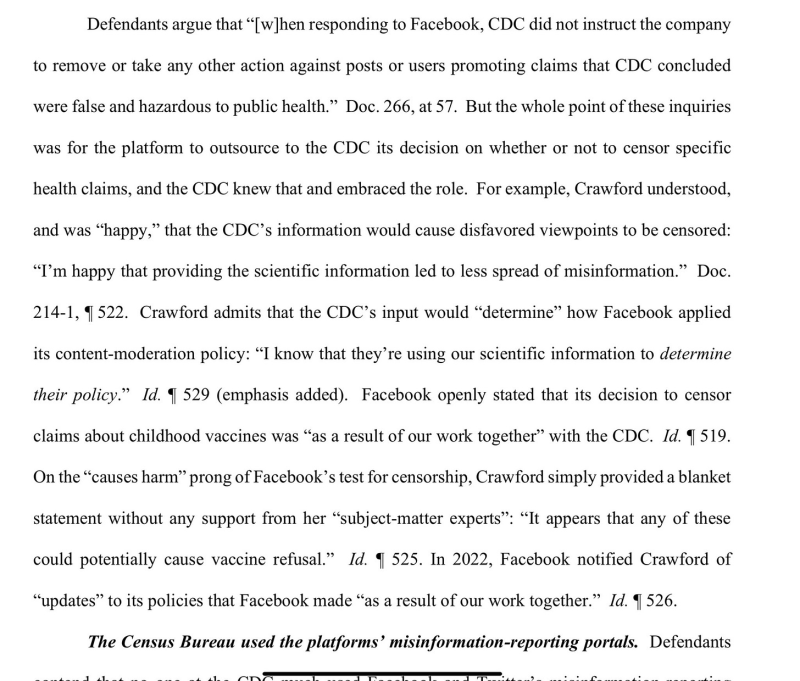Here we continue with a lightly edited version of reporter Tracy Beanz’s coverage of the case and our activities in court last week. Today we discuss how even the *Census Bureau* and the *Department of Treasury* engaged in the government’s censorship activities.
All throughout, the plaintiffs’ brief documents in detail the partnership between these institutions and the “private,” taxpayer-funded organizations they used to do their dirty work. Of particular interest here is the Virality Project and Stanford Internet Observatory (SIO). (As it happens, I am mentioned in the Twitter files due to a SIO report. They tried to dissect and discredit my legal analysis and failed.)

Here we learn more about the intricate web of public/private partnerships executing this censorship enterprise—what reporter Michael Shellenberger has aptly called the Censorship-Industrial Complex. The government is trying to argue they closed up shop—again—but public testimony and other information obtained during discovery begs to differ. This begins to give you a sense of the “anatomy” of the Censorship-Industrial Complex and some of the key players involved:

And not to be outdone, of course the CDC gets involved. It is the same laundry list of issues, every agency doing the same thing: censoring you for sharing your thoughts and information on social media. What I didn’t have on my “Censorship Bingo” card until now was the Census Bureau:

Understand, the purpose here wasn’t to provide the public with information for informed consent. The sole purpose—the only purpose of this push—was to stop “vaccine refusal.” They wanted every single person vaccinated no matter what objections individuals might raise. When Facebook asked the CDC for information in regards to several posts on the platform, the CDC responded “it appears that any of these could potentially cause vaccine refusal.” There isn’t talk of whether the posts were factually accurate—just talk of what they think the result of people reading those posts will be….

The CDC even used the platforms’ own tools to report accounts for censorship, demonstrating just how embedded the government has been inside the operations of these corporations. They could log in directly to company portals to report things they wanted action taken on. How did the government try to weasel an explanation for this one? “We no longer really meet with these platforms very much at all, judge. I mean, well, except for the CDC but that’s only with Google… mostly. For the most part. Pretty much.” Oh, okay.

Here they discuss CISA [Cybersecurity Infrastructure Security Agency, part of the Department of Homeland Security] and its “Switchboarding” activities, where multiple employees would simultaneously “intern” or vice-versa with EIP and Stanford, and take an active role in censorship via this “help desk.” Here the line between government and private organizations becomes entirely blurred.

The government continuously tried to argue that all of this behavior has “stopped.” Except that what we know about only “stopped” after this groundbreaking lawsuit was filed.

The government also claims that CISA had nothing to do with the EIP (Election Integrity Project); but through discovery in this case we learned that the EIP was formed precisely to be the “gap” between what the government thought they could get away with after pushing the envelope and what a private organization could do on behalf of the government. The problem is, under the First Amendment, the Supreme Court has made clear that the government cannot do through a private org what they cannot do officially. Both of these legally constitute state action.

Additionally, while the government claims (again) they have shut all of this down, senior CISA official Brian Scully testified in a deposition that they have widened their net to even conversations happening about the US banking system, the war in Ukraine, the US withdrawal from Afghanistan, and racial justice.
The Department of Treasury also coordinated with CISA to censor information that undermines “public confidence” in “financial services” and “financial systems.” Consider: if you raised questions about our banking system or the behavior of the Federal Reserve on Twitter or Facebook, the government was attempting to censor this information. This is a truly Orwellian monster operating under the flimsy excuse of protecting the “national security” and the “safety” of Americans. If you aren’t sufficiently alarmed yet, you should be.

Jen Easterly, head of CISA actually said the following (this is a direct quote): it is “really, really dangerous if people get to pick their own facts.” The condescending suggestion is that we need the government to pick our facts for us and spoon-feed these facts to us. She wanted to organize CISA to act as the coordination point for allagencies—hence the disinformation governance board that was later “disbanded” due to public criticism.

This series is republished from the author’s Substack
Published under a Creative Commons Attribution 4.0 International License
For reprints, please set the canonical link back to the original Brownstone Institute Article and Author.









